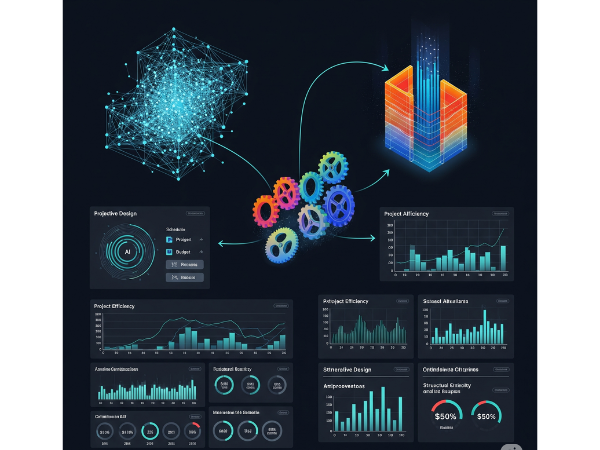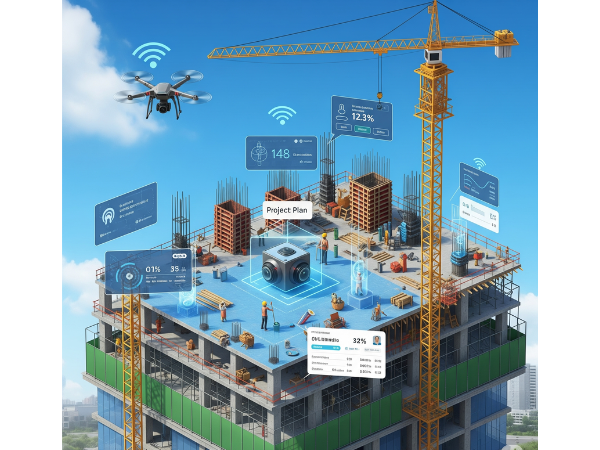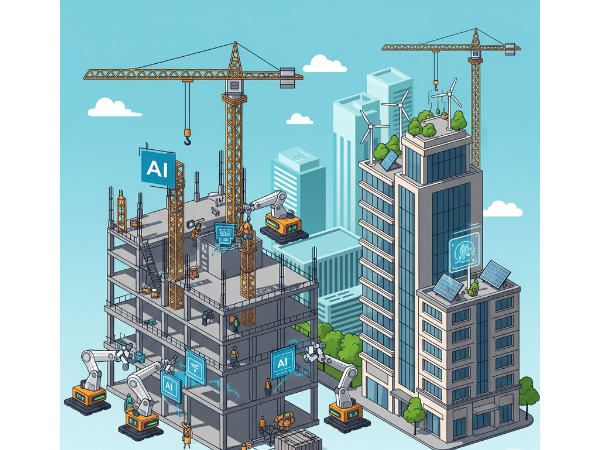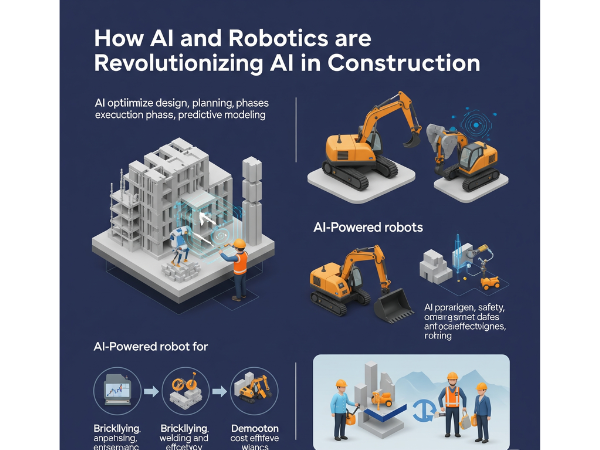The construction industry, often perceived as traditional and slow to adopt new technologies, is currently undergoing a monumental transformation. At the heart of this revolution lies the integration of Artificial Intelligence (AI) and robotics, fundamentally reshaping how projects are conceived, managed, and executed. The impact of AI in construction is profound, leading to unprecedented levels of efficiency, safety, and sustainability across the entire project lifecycle. This blog post delves into the myriad ways these cutting-edge technologies are paving the way for a smarter, more productive future for the built environment.

The Dawn of a New Era: Why AI in Construction Matters
For centuries, construction has relied heavily on manual labor, traditional methods, and often, reactive problem-solving. While effective, these approaches are prone to human error, safety risks, and significant inefficiencies. Enter AI in construction and robotics, offering solutions to these long-standing challenges. These technologies are not merely tools; they are intelligent partners capable of analyzing vast datasets, performing complex tasks with precision, and learning from experience. The push for digital transformation in construction is driven by the need for faster project delivery, reduced costs, enhanced worker safety, and a more environmentally responsible approach to building.
Boosting Efficiency with Artificial Intelligence in Construction
One of the most significant contributions of artificial intelligence in construction is its ability to optimize various processes, leading to substantial efficiency gains.
1. Project Planning and Design Optimization: AI algorithms can analyze historical project data, including schedules, budgets, and resource allocation, to create more accurate and optimized project plans. This predictive capability helps in identifying potential bottlenecks and risks even before they arise. Furthermore, AI-powered generative design tools can rapidly explore thousands of design permutations, optimizing for structural integrity, material usage, and even aesthetic appeal. This is a leap forward from traditional design methods, providing insights into factors like material selection and its impact on structural integrity.

2. Predictive Analytics for Resource Management: AI in construction can forecast material demand, equipment availability, and labor requirements with remarkable accuracy. By analyzing real-time data from sensors on job sites and external factors like weather patterns, AI systems can ensure that resources are deployed precisely when and where they are needed, minimizing waste and delays. This proactive approach ensures smoother operations and reduces costly downtime.
3. Enhanced Scheduling and Progress Monitoring: Advanced AI models can create dynamic project schedules that adapt to changing conditions. They can track progress in real-time using data from drones, IoT sensors, and wearable devices, instantly flagging deviations from the plan. This continuous monitoring allows project managers to make informed decisions and intervene promptly, keeping projects on track and within budget. This is particularly valuable in complex projects like high-rise buildings, where precise scheduling is crucial.

Enhancing Safety through Robotics in Construction
Safety remains a paramount concern in the construction industry, which historically has one of the highest rates of accidents. Robotics in construction is poised to dramatically improve safety by automating dangerous or repetitive tasks, thereby removing human workers from hazardous environments.
1. Autonomous Equipment and Drones: Self-driving construction vehicles, such as excavators, bulldozers, and dump trucks, can operate in conditions too risky for human operators, such as unstable ground or areas with falling debris. Drones, equipped with AI-powered cameras, can conduct detailed site inspections, monitor structural integrity, and survey hard-to-reach areas, all without putting human lives at risk. This capability extends to checking for common structural problems or even identifying signs that a building needs a structural inspection.
2. Robotic Demolition and Fabrication: Robots are increasingly being used for demolition tasks, handling heavy machinery and operating in hazardous zones. Similarly, in off-site fabrication, robotic arms can precisely cut, weld, and assemble components, ensuring consistency and quality while minimizing human exposure to dangerous machinery. This also ties into the benefits of pre-engineered buildings, where off-site fabrication plays a key role.
3. Exoskeletons for Worker Support: While not fully autonomous robots, exoskeletons are robotic suits that workers can wear to augment their strength and endurance. These devices reduce physical strain, prevent injuries from heavy lifting or repetitive motions, and extend the working life of skilled laborers. This shows how AI and robotics can directly support human workers, rather than entirely replacing them.
Driving Sustainability with AI and Robotics in Construction
The construction industry is a significant contributor to global resource consumption and waste generation. AI and robotics in construction offer powerful tools to promote more sustainable practices.
1. Optimized Material Usage and Waste Reduction: AI can analyze design plans and construction processes to optimize material quantities, minimizing off-cuts and waste. Robots can execute cuts and assemblies with extreme precision, further reducing material wastage. This not only lowers costs but also lessens the environmental footprint of projects.
2. Energy Efficiency in Buildings: AI-powered building management systems (BMS) can learn occupant behavior and external environmental conditions to optimize heating, ventilation, and air conditioning (HVAC) systems, significantly reducing energy consumption in completed structures. Furthermore, during construction, AI can help in selecting sustainable materials and eco-friendly approaches.
3. Carbon Footprint Reduction: By optimizing logistics, reducing waste, and improving the efficiency of machinery, AI in construction directly contributes to lowering the carbon emissions associated with construction projects. AI can even help engineers tackle climate change by fostering resilience in structures.

The Challenges and Future of AI in Construction
Despite the immense potential, the widespread adoption of AI in construction and robotics faces several challenges. These include the high initial investment costs, the need for a skilled workforce capable of operating and maintaining these advanced systems, and regulatory frameworks that are still catching up with technological advancements. Data privacy and cybersecurity are also critical concerns that need to be addressed as more construction processes become digitized.
However, the trajectory is clear. The future of the construction industry will be increasingly intertwined with AI and robotics in construction. We can expect to see:
- Human-Robot Collaboration: A seamless integration where humans and robots work side-by-side, leveraging each other’s strengths.
- Autonomous Job Sites: Sites where a significant portion of the work is performed by autonomous machines, overseen by human supervisors.
- Digital Twins: Comprehensive virtual models of physical structures that are updated in real-time, allowing for predictive maintenance, performance optimization, and informed decision-making throughout the building’s lifecycle.
- Advanced Data Analytics: Deeper insights derived from vast amounts of construction data, leading to continuous improvement in processes and outcomes.
The role of a structural engineer, for example, will evolve, focusing more on data interpretation and innovative design solutions rather than solely on traditional calculations. Similarly, BIM (Building Information Modeling) training will become even more crucial as a gateway to a future-ready AEC career.
Conclusion: Building Smarter with AI in Construction
The integration of AI in construction and robotics is not a distant dream; it is a current reality that is steadily gaining momentum. From enhancing project planning and optimizing resource management to significantly improving safety and driving sustainability, these technologies are ushering in an era of unprecedented progress in the construction sector. While challenges remain, the benefits far outweigh them, promising a future where buildings are constructed faster, safer, more cost-effectively, and with a far lighter environmental footprint. The construction industry is indeed building smarter, one intelligent machine and algorithm at a time. The future of the built environment is here, and it’s powered by AI in construction.
FAQ’s:-
Q1: What is the primary benefit of using AI in construction?
A1: The primary benefit of using AI in construction is the significant improvement in efficiency, safety, and sustainability across all project phases, from planning and design to execution and maintenance.
Q2: How do robotics improve safety on construction sites?
A2: Robotics improve safety by automating dangerous and repetitive tasks, allowing human workers to avoid hazardous environments, and by utilizing autonomous equipment and drones for inspections and operations in risky areas.
Q3: Can AI help with project budgeting and scheduling?
A3: Yes, AI in construction can analyze historical data to create more accurate budgets and dynamic schedules, and it can monitor real-time progress to flag deviations and ensure projects stay on track and within budget.
Q4: What are some challenges to adopting AI and robotics in construction?
A4: Key challenges include high initial investment costs, the need for a skilled workforce to operate and maintain the technology, and the development of appropriate regulatory frameworks. Data privacy and cybersecurity are also significant concerns.
Q5: Will AI and robots replace human workers in construction?
A5: While AI and robotics will automate many tasks, they are more likely to augment human capabilities rather than entirely replace human workers. The focus will shift towards human-robot collaboration, where humans oversee and manage these advanced systems, and roles will evolve, as seen in the changing role of a structural engineer.
Read More On:-
For more information about engineering, architecture, and the building & construction sector, go through the posts related to the same topic on the Specuwin Blog Page.
Find out more accurately what we are going to take off in the course of applying leading new technologies and urban design at Specuwin.
